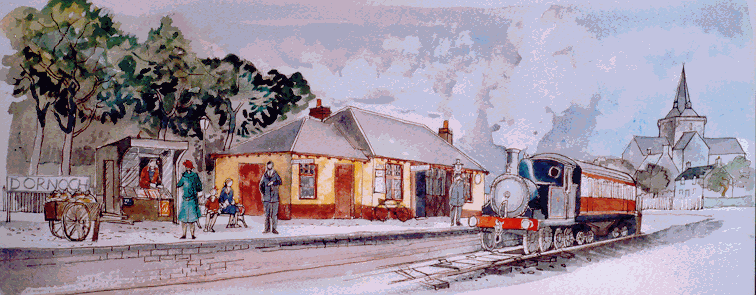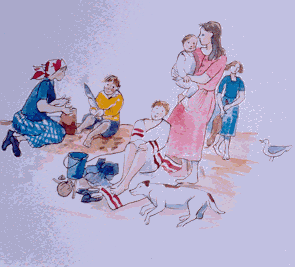
20th Century
More has happened over the past 100 years to change the social and physical fabric of Dornoch than occurred in the previous 1000 years. New technology, improved transport links, innovative social legislation, two world wars and the growth of the tourism and leisure industries have all combined to provide the town with a brighter future than at any other time in its history.
Transport
 In 1902 a branch line between Dornoch and the Mound (some seven miles to the north of the town) was finally opened, thereby connecting Dornoch with the main Highland line. The line remained in operation for 58 years and opened up the town to increasing numbers of visitors who were attracted to the area by the golf courses, magnificent scenery and the invigorating sea air.
In 1902 a branch line between Dornoch and the Mound (some seven miles to the north of the town) was finally opened, thereby connecting Dornoch with the main Highland line. The line remained in operation for 58 years and opened up the town to increasing numbers of visitors who were attracted to the area by the golf courses, magnificent scenery and the invigorating sea air.
Road transport gradually improved, particularly after World War Two, while between the wars an increasing number of wealthy visitors from England flew north to Inverness before continuing their journey to Sutherland by road. The upgrading of the A9 during the last two decades and the opening of the Dornoch Bridge in 1991 has made the area even more accessible to visitors.
The world at war
Like many other rural communities throughout Britain, Dornoch suffered terribly from the loss of a significant number of young men who were killed or wounded in action during the two World Wars. To this day the town and parish remembers those who lost their lives at the annual Remembrance Service and Parade on 11 November at the war memorial on the outskirts of the town.
During both wars foreign troops were stationed in and around Dornoch: in both WW1 and WW2 Canadian troops established logging camps in the area, while Norwegian and Indian troops were billeted here during WW2. Other events of note 1939-45 were the formation of a local Home Guard unit and the RAF development of the airstrip on the town’s links to become 40 Satellite Landing Ground (SLG) and subsequently 46 Maintenace Unit (MU), used for the storage and preparation of aircraft for service.
Golf and social change
Today Dornoch’s main industry is tourism. During the 1890s John Sutherland, Secretary to Dornoch Golf Club, tirelessly promoted the town and the golf club in the national press. Every summer wealthy visitors either rented house for the summer months or built their own residences. The opening of the railway and the Station Hotel at the beginning of the century attracted even more visitors. Between the wars the wealthy still patronised the town. Locals recall seeing Rolls Royces and Daimlers lined up in front of the Sutherland Arms Hotel and the Station Hotel. Golf was still the principal attraction, but visitors were beginning to realise that the area had other natural advantages.
 After the Second World War the wealthy began to travel abroad for their holidays. Several of the large Dornoch holiday homes were turned into hotels (most notably the Burghfield House Hotel and the Royal Golf Hotel) that catered for the professional middle classes who began to holiday in the Highlands during the summer.
After the Second World War the wealthy began to travel abroad for their holidays. Several of the large Dornoch holiday homes were turned into hotels (most notably the Burghfield House Hotel and the Royal Golf Hotel) that catered for the professional middle classes who began to holiday in the Highlands during the summer.
With the opening of campsites at Embo and Dornoch, more and more tourists (from all walks of life) came to the area, particularly after car ownership in Britain expanded during the 1960s.
Official statistics for the early 1990s indicate that as many as 300,000 tourists visit Dornoch annually, an impressive statistic when one considers the many other attractive holiday destinations that can be found throughout the United Kingdom.
Conclusion
Dornoch is a prosperous town known to visitors from all over the world. Golf remains its main attraction, but the beaches, mountains and spectacular ruggedness of the local landscape all contribute to the area’s popularity.
Most visitors have no real idea of the town’s history; most will assume that Dornoch has enjoyed a fairly placid, undisturbed existence over the centuries. Hopefully this brief summary of the town’s past has shown that Dornoch’s geographical remoteness did not spare it from the bitter disputes, clan rivalries, religious and social divisions that make up so much of the rest of Scotland’s turbulent past. Indeed, the poverty and social deprivation that was so much a part of Dornoch’s way of life during the 18th and 19th centuries, makes the town’s twentieth century relative prosperity seem even more remarkable.
Little physical evidence remains of the town’s past, but it is hoped that by following the Historylinks Trail and visiting the museum, young history students will experience at least a taste of what life in Dornoch must have been like before the tourists came.

